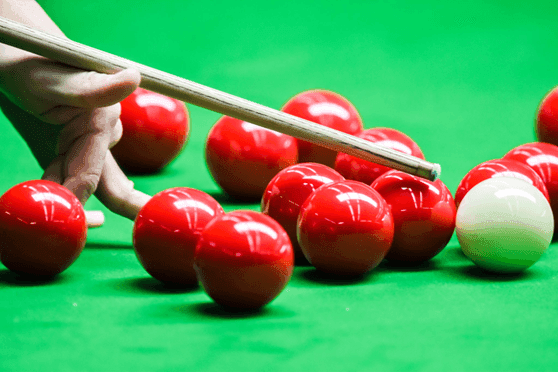Snooker
The Rules of Snooker: An In-Depth Guide
Unlock the essence of snooker with a comprehensive guide covering rules, strategies, and insights into the captivating world of competitive cue sports.

Image Credits: Discovery
Unlocking the Essence of Snooker
Snooker, a captivating cue sport demanding precision, strategy, and skill, offers enthusiasts a thrilling journey into the realm of competitive cue games. Despite its seemingly straightforward premise of potting balls in a sequential order to score points, the intricacies of its rules sculpt the game into a sophisticated contest of strategy and finesse.
In this comprehensive guide, we embark on an exploration of the fundamental rules of snooker, providing clarity and depth to your understanding of this beloved sport.
The Origins of Snooker
Before delving into the specifics, it's essential to grasp the origins and objectives that underpin the game of snooker. Emerging in the latter half of the 19th century among British army officers stationed in India, snooker gradually gained traction, captivating audiences far beyond its initial confines.
The etymology of its name, believed to stem from a colloquialism denoting first-year cadets or inexperienced soldiers, hints at its humble beginnings. Today, snooker stands as a pillar of international cue sports, meticulously regulated by the esteemed World Snooker Tour.
The Main Objectives of Snooker
At its core, snooker beckons players to outmanoeuvre their opponents, striving to accumulate more points through adept ball potting and strategic play. A standard snooker table hosts 22 balls, comprising 15 red balls, each valued at a singular point, and 6 coloured balls — yellow, green, brown, blue, pink, and black — each carrying varied point values ranging from 2 to 7. The objective is straightforward: to surpass one's opponent in points by skilfully potting balls in the prescribed sequence.
To commence a frame, players confront the meticulously arranged balls, poised for action. The ritualistic break-off shot initiates the gameplay, requiring the player to pot a red ball followed by a coloured one. This strategic manoeuvre not only kickstarts the scoring but also sets the stage for subsequent plays. As the game unfolds, players navigate a labyrinth of reds and coloured balls, adhering strictly to the hierarchical order dictated by their point values.
In the following sections, we embark on a detailed exploration of the rules governing each facet of snooker, empowering you with the knowledge to navigate the complexities of this venerable sport with confidence and finesse.
Essential Equipment for Snooker
Central to the gameplay is the snooker table, measuring 12 feet by 6 feet, adorned with six pockets strategically positioned along its perimeter. Draped in a green baize cloth, the table boasts cushions that facilitate precise ball movement and rebounds.
The array of balls adorning the table includes 15 reds, complemented by 6 coloured balls as previously mentioned.
The cue, a quintessential tool in the player's arsenal, must adhere to specific dimensions, not exceeding 57 inches in length and devoid of added weights. Its tapered end facilitates the delicate art of potting balls with finesse and accuracy.
Additionally, the equipment roster encompasses indispensable accessories such as rests, chalk for cue maintenance, and measures, ensuring players are equipped for the nuanced challenges that lie ahead on the green baize battlefield.
Setting Up and Breaking: Initiating the Action
When preparing the snooker table, the 15 red balls are meticulously arranged into a triangle formation, positioned just behind the foot spot. Adjacent to this formation, the pink ball finds its place in front of the triangle, while the black ball is situated behind it. On the opposite end of the table, along the baulk line, the brown ball occupies the central position. Extending from the baulk line is a semicircle, with the black ball nearest to the observer. Positioned on the left-hand corner of this semicircle is the yellow ball, while the green ball finds its place on the right-hand side, completing the symmetrical arrangement.

Image Credits: Sporting News
The action kicks off with the break-off shot, where the player hits the cue ball from the baulk area, aiming to hit a red ball. If any balls are potted during this shot, the player keeps their turn. However, if no balls are potted, it's the opponent's turn to play.
Order of Play in Snooker
In the dynamic flow of snooker, the order of play follows a precise set of rules. After potting a ball, the subsequent shot must be taken from the position where the cue ball comes to rest, unless a foul occurs.
While reds must always be potted before any coloured ball, the sequence of reds doesn't matter. However, when it comes to the coloured balls, they must be potted in ascending order of points value, starting from yellow and culminating with the black.
Before each shot, the player must declare their intention by nominating the next ball they aim to pot, or they can opt for a safety shot to strategically impede their opponent's progress. Once all reds are cleared from the table, the coloured balls are subsequently potted in their numerical order, following the hierarchy of their points value.
Understanding Points in Snooker
Points are the currency of victory, with each ball's value dictating the path to success. Reds, the foundational orbs of the game, are valued at a modest yet crucial 1 point each, while the coloured balls carry varying point values ranging from 2 to 7.
The points value of each ball is as follows: there are 15 red balls, each worth 1 point. Additionally, there is one yellow ball worth 2 points, one green ball worth 3 points, one brown ball worth 4 points, one blue ball worth 5 points, one pink ball worth 6 points, and finally, one black ball worth 7 points.
As players deftly manoeuvre across the green baize, their scores steadily ascend with each successful pot, accumulating points during their turn at the table. The ultimate goal is to be the first to reach the predetermined target score, typically set at 147 points in professional matches, thus clinching victory in the frame and asserting mastery over the green-felt battlefield.
Strategic Snooker Tips within the Rules
Furthermore, here are a few strategic tips to consider within the rules of snooker. These insights delve into key aspects of gameplay, offering guidance on how to navigate the intricacies of the game with finesse and tactical acumen.
- 1
Positional Play: Mastering cue ball placement after each shot is pivotal for both offense and defence. Strategic positioning enables controlled pots or safety plays, while avoiding risky situations that could shift momentum to your opponent.
- 2
Tactical Fouls: Sometimes, committing a minor tactical foul can be advantageous compared to leaving an easy open pot. This grants the ball in hand for defensive manoeuvres, although consecutive fouls incur escalating penalties.
- 3
Strategic Safeties: In challenging scoring situations, shrewd players adeptly manoeuvre the cue ball into snookered positions or behind object balls to obstruct easy pots. This tactic not only frustrates opponents but also buys valuable thinking time.
- 4
Scoring Tempo: Unlike conventional sports, snooker's scoring rate fluctuates with breaks made. Savvy players recognize when to slow down the scoring pace by playing safe, thereby retaining control of the match.
- 5
Utilising the Cue Butt: During close-range technical shots, utilising the thicker butt end of the cue on the table ensures steadiness and precision. This technique enables players to execute daring cannons and pots while minimizing errors.
A Snooker Conclusion
In conclusion, snooker's intricate rules intricately shape every aspect of play and scoring, demanding a thorough understanding for appreciating the game's skill and tactics. While the basic objective appears straightforward, strategic complexities like fouls and safeties add depth to gameplay. Mastering these technicalities and making split-second decisions under pressure separates exceptional players from the rest, showcasing talent, chance, and mind games.
This guide aims to provide insights into the underlying mechanics of snooker, from setup to scoring, allowing readers to better appreciate the genius of top professionals and their strategic manoeuvres within the bounds of the rules.
FAQs
The duration of a game of snooker can vary depending on several factors. For professional matches played at a high standard, it usually takes around 20 to 25 minutes to complete a single frame. However, this timing can fluctuate based on the opportunities players encounter and the arrangement of the red balls on the table.
Exceptionally fast players like Ronnie O'Sullivan can complete a frame in as little as 10 to 15 minutes. On the other hand, particularly complex frames can extend beyond 2 hours.
For beginners or less experienced players, a single frame might take up to an hour to finish, though it's challenging to provide an exact estimate.
Matches consisting of Best of 11 or 13 frames typically conclude within one day. However, matches with 15 frames or more are often spread across multiple days, continuing into the next day to accommodate the extended duration of play.
In snooker, a push shot arises when a player intentionally nudges or moves any ball with the cue tip during a shot. Such actions disrupt the natural positioning of the balls and are deemed fouls. To adhere to the rules, the cue tip must cleanly strike the cue ball with a single forceful motion, without any pushing or nudging of other balls.
"Ball in hand" denotes the advantage awarded to a player after their opponent commits a foul. This privilege allows the incoming player to position the cue ball anywhere on the table, except in contact with another ball or near the cushions. Essentially, it grants the player an advantageous starting position for their next shot, following their opponent's error.
For more guides and news in the snooker world, make sure to follow Sportsboom.com.

Meet Louis Hobbs, our esteemed authority on all matters sports-related. With a wealth of knowledge and experience, Louis effortlessly emerges as our go-to expert. His particular expertise in the realms of darts and snooker sets him apart and brings a level of insight that goes beyond the ordinary. Louis also holds a deep affection for all things related to US sports, with a special emphasis on basketball and American football, which stand out as his particular favorites. His content may not resonate with you, if you don't consider Lamar Jackson the most skilled player in the NFL.
